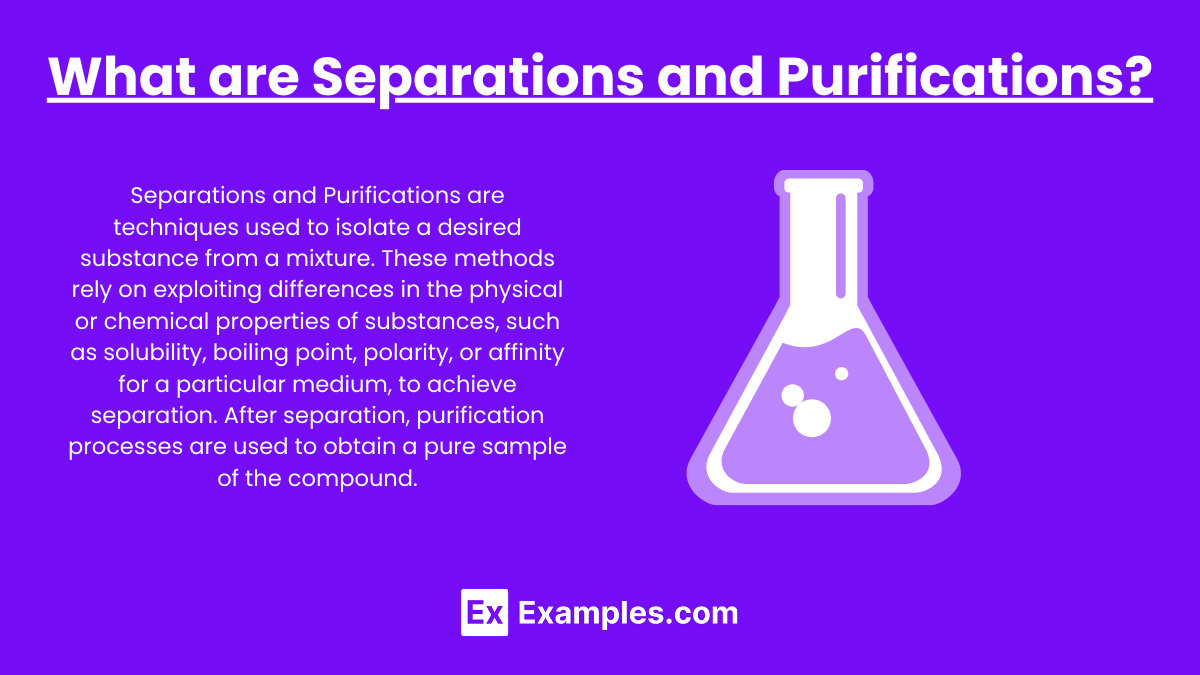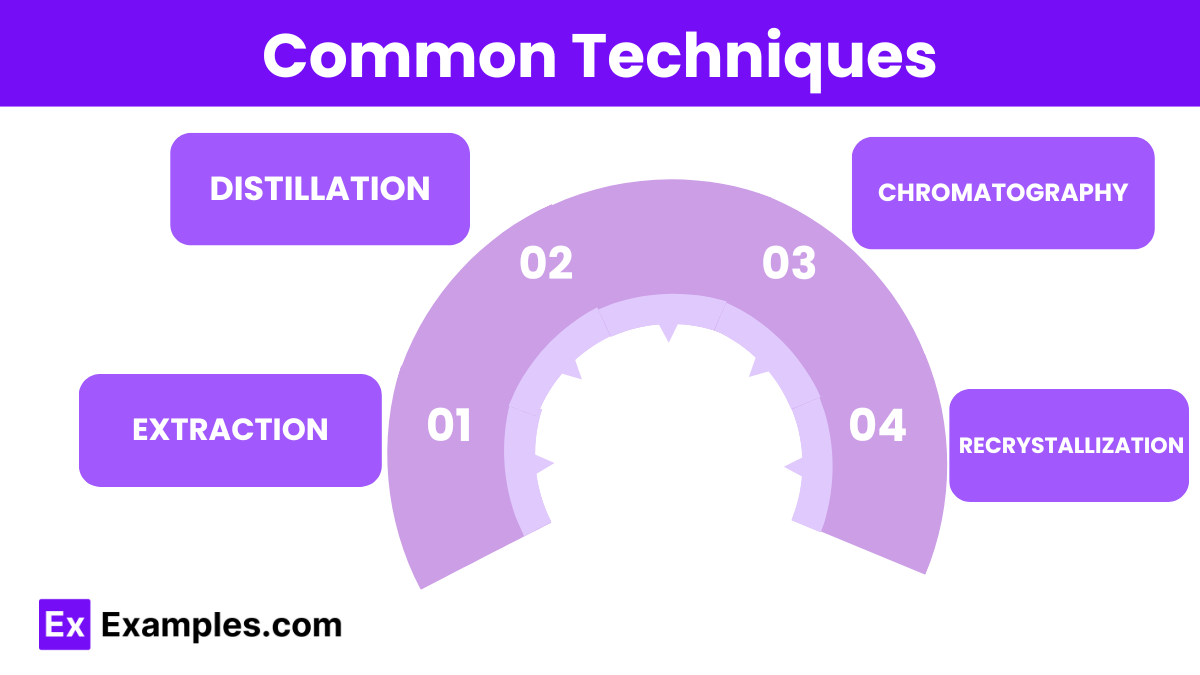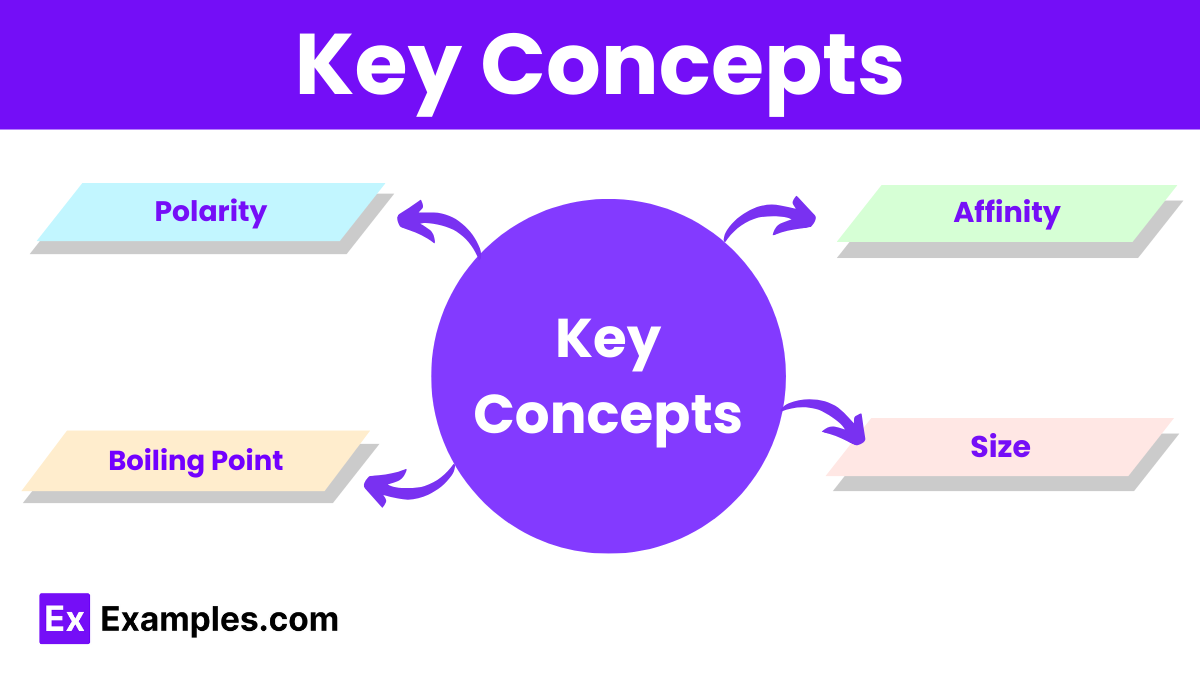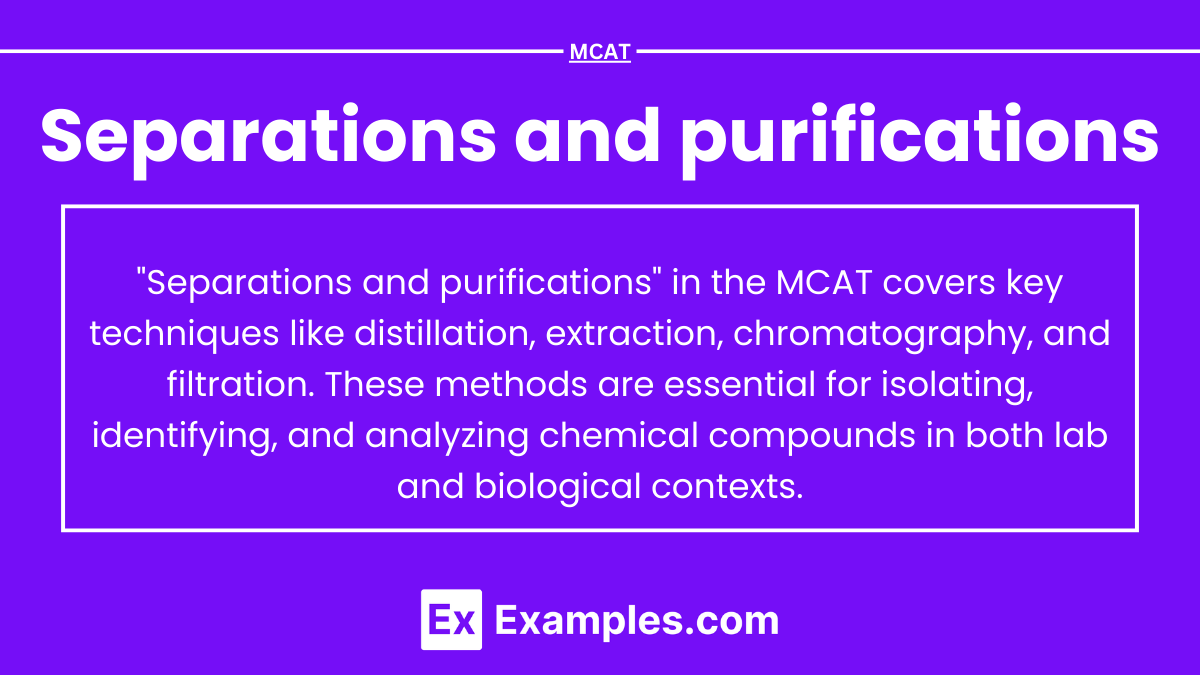Separations and Purifications

- Notes
Separations and purifications are critical techniques used in chemistry to isolate and purify compounds from mixtures. For the MCAT, understanding these methods helps in analyzing reaction products, characterizing compounds, and identifying molecular interactions in biological systems.
Learning Objectives
In studying separations and purifications for the MCAT, you should understand the basic principles behind common techniques such as extraction, distillation, chromatography, and recrystallization. You should also recognize how these methods exploit differences in physical properties like solubility, boiling point, polarity, and molecular size to separate components. Mastering these concepts will help you evaluate laboratory procedures and analyze experimental results.
What are Separations and Purifications?

Separations and Purifications are techniques used to isolate a desired substance from a mixture. These methods rely on exploiting differences in the physical or chemical properties of substances, such as solubility, boiling point, polarity, or affinity for a particular medium, to achieve separation. After separation, purification processes are used to obtain a pure sample of the compound.
Common Techniques

- Extraction: A technique that uses the difference in solubility between compounds in two immiscible solvents (typically an aqueous and an organic phase) to separate them. Compounds are selectively dissolved into one of the two layers based on their solubility.
- Distillation: A method that separates liquids based on differences in their boiling points. It involves heating a mixture to boil off the more volatile component, which is then condensed into a separate container.
- Simple Distillation: Used when the boiling points of the components differ significantly.
- Fractional Distillation: Used when the boiling points of the components are closer together. It utilizes a fractionating column to increase the efficiency of separation.
- Chromatography: A method that separates compounds based on their interaction with a stationary phase and a mobile phase. Components of the mixture travel at different speeds, leading to their separation.
- Thin-layer Chromatography (TLC): A simple technique using a thin stationary phase (like silica) on a glass or plastic plate. The solvent moves up the plate, carrying the components at different rates.
- Gas Chromatography (GC): Separates volatile compounds based on their affinity for the stationary phase and their boiling points as they are carried through a column by an inert gas.
- High-Performance Liquid Chromatography (HPLC): A technique used to separate and analyze compounds that are not volatile, utilizing high pressure to push the liquid through a stationary phase.
- Recrystallization: A method of purifying solid compounds by dissolving them in a hot solvent and then cooling the solution. The pure compound crystallizes out, leaving impurities in the solvent.
Key Concepts

- Polarity: Many separation techniques rely on differences in polarity. For example, in extraction, polar compounds will dissolve in the aqueous layer, while nonpolar compounds will dissolve in the organic layer.
- Boiling Point: Distillation uses the boiling point difference to separate volatile components.
- Affinity: Chromatography separates compounds based on their affinity for the stationary phase compared to the mobile phase. Polar compounds tend to adhere to polar stationary phases, moving slower through the column.
- Size: Some methods, like size-exclusion chromatography, separate molecules based on their size, with larger molecules eluting first.
Examples
Example 1: Liquid-Liquid Extraction
A mixture of benzoic acid (polar) and toluene (nonpolar) can be separated using liquid-liquid extraction. Benzoic acid is soluble in the aqueous layer when treated with a base (forming benzoate), while toluene remains in the organic layer. The layers are separated, and the benzoate can be acidified to regenerate benzoic acid.
Example 2: Fractional Distillation
A mixture of ethanol (boiling point 78°C) and water (boiling point 100°C) can be separated by fractional distillation. The fractionating column allows the ethanol to vaporize and condense multiple times, leading to a higher purity of ethanol as it distills out of the mixture.
Example 3: Thin-layer Chromatography (TLC)
A mixture of dyes can be separated using TLC. The plate is coated with silica (a polar stationary phase), and a solvent (mobile phase) moves the dyes up the plate. Nonpolar dyes travel further, while polar dyes interact more with the silica and move slower.
Example 4: Recrystallization of Acetanilide
Acetanilide can be purified by dissolving it in hot water. As the solution cools, pure acetanilide crystallizes out, while impurities remain dissolved in the water. The crystals are collected by filtration.
Example 5: Column Chromatography
In column chromatography, a mixture is passed through a column packed with a stationary phase (usually silica or alumina). As the mixture flows through the column, the components separate based on their affinities for the stationary phase versus the mobile phase. Compounds that have a greater affinity for the stationary phase move more slowly, allowing them to be collected separately. This method is useful for purifying larger amounts of compounds compared to thin-layer chromatography.
Practice Questions
Question 1:
Which technique would best separate a mixture of hexane and water?
A) Thin-layer chromatography
B) Simple distillation
C) Liquid-liquid extraction
D) Recrystallization
Answer: C) Liquid-liquid extraction
Explanation: Hexane is a nonpolar organic compound, while water is polar. Liquid-liquid extraction would use these differences in solubility to separate the two compounds. Hexane would dissolve in an organic solvent, and water would remain in the aqueous layer.
Question 2:
Which of the following mixtures could be separated using fractional distillation?
A) Ethanol (boiling point 78°C) and water (boiling point 100°C)
B) Benzene (boiling point 80°C) and pentane (boiling point 36°C)
C) Water and sand
D) Sodium chloride and water
Answer: A) Ethanol (boiling point 78°C) and water (boiling point 100°C)
Explanation: Fractional distillation is best suited for separating mixtures of liquids with close boiling points, such as ethanol and water. The fractionating column increases the efficiency of the separation. The other choices involve mixtures that are not appropriate for distillation.
Question 3:
Which chromatographic method would be most appropriate for separating a mixture of volatile compounds?
A) Thin-layer chromatography
B) Gas chromatography
C) High-performance liquid chromatography
D) Column chromatography
Answer: B) Gas chromatography
Explanation: Gas chromatography is ideal for separating volatile compounds. The mixture is vaporized and carried through a column by an inert gas, with separation occurring based on boiling points and interaction with the stationary phase.
Separations and purifications are critical techniques used in chemistry to isolate and purify compounds from mixtures. For the MCAT, understanding these methods helps in analyzing reaction products, characterizing compounds, and identifying molecular interactions in biological systems.
Learning Objectives
In studying separations and purifications for the MCAT, you should understand the basic principles behind common techniques such as extraction, distillation, chromatography, and recrystallization. You should also recognize how these methods exploit differences in physical properties like solubility, boiling point, polarity, and molecular size to separate components. Mastering these concepts will help you evaluate laboratory procedures and analyze experimental results.
What are Separations and Purifications?
Separations and Purifications are techniques used to isolate a desired substance from a mixture. These methods rely on exploiting differences in the physical or chemical properties of substances, such as solubility, boiling point, polarity, or affinity for a particular medium, to achieve separation. After separation, purification processes are used to obtain a pure sample of the compound.
Common Techniques
Extraction: A technique that uses the difference in solubility between compounds in two immiscible solvents (typically an aqueous and an organic phase) to separate them. Compounds are selectively dissolved into one of the two layers based on their solubility.
Distillation: A method that separates liquids based on differences in their boiling points. It involves heating a mixture to boil off the more volatile component, which is then condensed into a separate container.
Simple Distillation: Used when the boiling points of the components differ significantly.
Fractional Distillation: Used when the boiling points of the components are closer together. It utilizes a fractionating column to increase the efficiency of separation.
Chromatography: A method that separates compounds based on their interaction with a stationary phase and a mobile phase. Components of the mixture travel at different speeds, leading to their separation.
Thin-layer Chromatography (TLC): A simple technique using a thin stationary phase (like silica) on a glass or plastic plate. The solvent moves up the plate, carrying the components at different rates.
Gas Chromatography (GC): Separates volatile compounds based on their affinity for the stationary phase and their boiling points as they are carried through a column by an inert gas.
High-Performance Liquid Chromatography (HPLC): A technique used to separate and analyze compounds that are not volatile, utilizing high pressure to push the liquid through a stationary phase.
Recrystallization: A method of purifying solid compounds by dissolving them in a hot solvent and then cooling the solution. The pure compound crystallizes out, leaving impurities in the solvent.
Key Concepts
Polarity: Many separation techniques rely on differences in polarity. For example, in extraction, polar compounds will dissolve in the aqueous layer, while nonpolar compounds will dissolve in the organic layer.
Boiling Point: Distillation uses the boiling point difference to separate volatile components.
Affinity: Chromatography separates compounds based on their affinity for the stationary phase compared to the mobile phase. Polar compounds tend to adhere to polar stationary phases, moving slower through the column.
Size: Some methods, like size-exclusion chromatography, separate molecules based on their size, with larger molecules eluting first.
Examples
Example 1: Liquid-Liquid Extraction
A mixture of benzoic acid (polar) and toluene (nonpolar) can be separated using liquid-liquid extraction. Benzoic acid is soluble in the aqueous layer when treated with a base (forming benzoate), while toluene remains in the organic layer. The layers are separated, and the benzoate can be acidified to regenerate benzoic acid.
Example 2: Fractional Distillation
A mixture of ethanol (boiling point 78°C) and water (boiling point 100°C) can be separated by fractional distillation. The fractionating column allows the ethanol to vaporize and condense multiple times, leading to a higher purity of ethanol as it distills out of the mixture.
Example 3: Thin-layer Chromatography (TLC)
A mixture of dyes can be separated using TLC. The plate is coated with silica (a polar stationary phase), and a solvent (mobile phase) moves the dyes up the plate. Nonpolar dyes travel further, while polar dyes interact more with the silica and move slower.
Example 4: Recrystallization of Acetanilide
Acetanilide can be purified by dissolving it in hot water. As the solution cools, pure acetanilide crystallizes out, while impurities remain dissolved in the water. The crystals are collected by filtration.
Example 5: Column Chromatography
In column chromatography, a mixture is passed through a column packed with a stationary phase (usually silica or alumina). As the mixture flows through the column, the components separate based on their affinities for the stationary phase versus the mobile phase. Compounds that have a greater affinity for the stationary phase move more slowly, allowing them to be collected separately. This method is useful for purifying larger amounts of compounds compared to thin-layer chromatography.
Practice Questions
Question 1:
Which technique would best separate a mixture of hexane and water?
A) Thin-layer chromatography
B) Simple distillation
C) Liquid-liquid extraction
D) Recrystallization
Answer: C) Liquid-liquid extraction
Explanation: Hexane is a nonpolar organic compound, while water is polar. Liquid-liquid extraction would use these differences in solubility to separate the two compounds. Hexane would dissolve in an organic solvent, and water would remain in the aqueous layer.
Question 2:
Which of the following mixtures could be separated using fractional distillation?
A) Ethanol (boiling point 78°C) and water (boiling point 100°C)
B) Benzene (boiling point 80°C) and pentane (boiling point 36°C)
C) Water and sand
D) Sodium chloride and water
Answer: A) Ethanol (boiling point 78°C) and water (boiling point 100°C)
Explanation: Fractional distillation is best suited for separating mixtures of liquids with close boiling points, such as ethanol and water. The fractionating column increases the efficiency of the separation. The other choices involve mixtures that are not appropriate for distillation.
Question 3:
Which chromatographic method would be most appropriate for separating a mixture of volatile compounds?
A) Thin-layer chromatography
B) Gas chromatography
C) High-performance liquid chromatography
D) Column chromatography
Answer: B) Gas chromatography
Explanation: Gas chromatography is ideal for separating volatile compounds. The mixture is vaporized and carried through a column by an inert gas, with separation occurring based on boiling points and interaction with the stationary phase.

